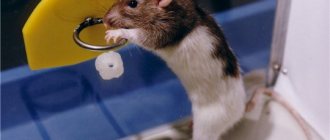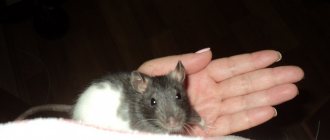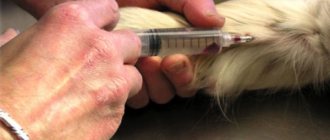Important!!! A pet rat should be given daily walks and play outside its cage for at least two hours a day under the supervision of its owner.
What and how can you play with your pet rat?
The decorative rat is characterized by curiosity and mobility. An intelligent and playful pet rodent who loves pranks and fun. It is very important to find time to play with your pet - this is connected not only with maintaining an emotional connection with your pet, but also with fulfilling the animal’s need for physical activity. The lack of daily physical activity is fraught with the development of obesity and other serious diseases for the rodent. To keep the animal healthy, you need to provide it with a daily marathon (at least 2 hours), in which a walk will be combined with games.
Vaccination
Decorative rats do not need vaccination. No drugs have been developed for them to help prevent the development of diseases in these animals.
Selection and accessories for your pet
An animal's cell must contain several elements:
- drinking bowl;
- feeder;
- nest (place to sleep);
- a mineral stone on which the animal will grind its teeth.
To prevent the animal from getting bored, toys are placed in the house. Rats are very fond of such a device as a hammock. It can be made from a piece of durable fabric or purchased ready-made at a pet store.
Most preferred toys:
- ladders, including rope ones;
- tunnels;
- labyrinths.
How to play with rats
It is important to play with the rat correctly. The main thing when playing with a small pet is safety, therefore:
- All games and walks outside the cage are under the control of the owner - leaving the rodent unattended is prohibited.
- It is advisable to cover sofas, chairs and other furniture in advance with a material of a color against which the little fugitive would be immediately noticeable.
Before letting your pet out of the cage, you should make sure that he will be out of access to such objects as:
- wires;
- bin;
- houseplants;
- other pets (if any in the house);
- open doors and windows;
- ventilation vents;
- cracks etc.
Article on the topic: A hamster has died: how to understand and what to do
During the game (and any other time) it is strictly prohibited:
- lift or pull the rat by the tail;
- step on or sit on a rodent;
- squeeze your pet tightly;
- raise the animal high.
Such treatment of a pet is unacceptable under any circumstances.
Mouse specifics
Generally speaking, mice, unlike rats, love cereals, cereals, fruits and vegetables more than animal products. However, one of the most reliable baits in a mousetrap is rightfully considered a piece of lard, slightly fried with a match on one side.
In addition to lard, the mouse trap can be charged:
- A crust of bread soaked in vegetable oil;
- A piece of apple or pear;
- Walnut kernel;
- A piece of smoked sausage (which also attracts rats).
In general, mice are less suspicious of baits than rats.
On a note
As for cheeses, of which there is a great variety on sale, here the opinions of rodent fighters differ. Some consider the use of cheese to catch mice to be completely ineffective, while others, on the contrary, claim that certain brands of odorous cheese catch mice in mousetraps quite well.
Be that as it may, cheese is hardly the product that mice or rats love most.
In mousetraps in which the bait is not attached to the guard, in addition to all of the above products, you can also put fried seeds, fried peanuts, rye crackers and oatmeal cookies.
Porridge, mashed potatoes and dough, all with the addition of vegetable oil, are good food bases for mouse poisoning. These mouse baits are the most versatile and easy to prepare. The same Zookoumarin, Krysid and Ratindan can be used as poison.
What can you play with a rat at home?
It is recommended to provide your pet with interesting leisure time both in and outside the cage. This is not difficult to do. It is highly desirable to have the following equipment in the animal’s cage:
- running wheels;
- ladder;
- tunnels;
- wooden toys;
- plastic balls (for example, table tennis);
- hammocks;
- shelves, etc.
This will provide the animal with exciting and useful leisure time within the walls of its own cage. As for entertainment outside the cage, at home you can play the entertaining games presented below with a small, active and inquisitive rodent.
Cat and mouse
The animal will enjoy hunting for a “mouse” attached to a strong thread or rope. The “mouse” can be:
The game is simple - you need to move a rope around the rat. The “mouse” will follow the thread, and the animal will enthusiastically attack the object, cheerfully jumping up and having fun.
Rabotage
This game, in essence, is a fight between a rodent and an opponent, whose role is the owner’s hand. It’s easy to captivate the animal - just move your fingers near the floor, depicting a small living creature moving. Having noticed a “competitor”, the animal will want to overcome it.
Gym
You can construct a unique sports and entertainment complex for your pet with your own hands using available materials. To work you will need:
- plastic bottles (for tunnels);
- cardboard boxes (for pens, towers, maze stages).
In the boxes, it is important to make openings for transitions that correspond in width to the size of the animal. The design of the complex is arbitrary - you should rely only on your imagination and the amount of consumables at hand.
Article on the topic: How to train a rat at home: education and training to commands
Hide and seek
Decorative rats love this game. Moreover, you don’t need to look for the animal. For hide and seek with a rodent, you just need to choose one of two main game options:
- Place a randomly crumpled blanket or large towel on the sofa or floor and run the animal under it.
- Place your pet in your bosom - under a robe or jacket, preferably with long sleeves.
The little traveler will be happy to tinker under the fabric. Every time he sticks his face out from somewhere, you need to praise him and encourage him.
hidden treasures
You just need to hide the treat inside the box or under crumpled cloth. Then all that remains is to watch with interest how the little tracker will look for a tasty “treasure”, relying on his sense of smell.
Training
A smart pet can be taught simple tricks - jumping through a hoop or from “stand to stand”, etc. The rat is capable of spinning on a hoop, fetching small things, etc.
Proper training strengthens the friendship between owner and pet. The main thing is not to forget to praise your pet and reward it with goodies during training.
Bathing
If the animal likes to “take a bath,” you can please him with this procedure. To do this you need:
- Fill the basin with warm water 5 cm from the bottom.
- Place an inverted bowl or container on the bottom to create an island (the bottom of the bowl should stick out of the water).
After bathing, the rat needs to be dried so that its fur is dry, otherwise the animal will catch a cold.
We will set up an indoor play area
First, you need to clear the area of anything that could harm your rats. While the play area will be enclosed with a barrier, the rodent may be harmed by bright lights, vents, and electrical wires. Clear the area of chemicals, wires, sharp objects and anything that gives off smoke, such as candles.
Choose a location away from walkways and other pets. The best place for a play area would be a corner in the living room with a wooden floor. Just keep the play area clear of things that you don't want to get damaged or become chewed on.
How to play with baby rats
You can start playing with babies only after going through the adaptation period. When the pups get comfortable in their new place, you can begin taming them in a playful way. Allowed:
- carry them in your arms;
- let them play with safe things (it’s good if they have the owner’s smell);
- let them run around the table or sofa;
- put them in your bosom and let them wander under your jacket.
Article on the topic: Harness and leash for rats: application, purpose, manufacture
Any actions should be accompanied by affectionate conversations, stroking and preferably treats.
Reproduction
How to determine gender?
Males can be distinguished from females by their enlarged testicles, which are clearly visible already at the age of 2–3 weeks. In female decorative rats, the rudiments of nipples are observed during this period of life.
Mating
Sexual maturity occurs early - at the age of 5–6 weeks. But individuals from 8 to 10 weeks are recommended for mating. In order to get offspring, it is enough to leave the male and female in the same cage for a couple of days. But you need to understand that fertilization is possible only if the female is in heat. It occurs regularly at intervals of 4–7 days.
Pregnancy
From the moment of fertilization to the birth of rat pups, no more than 23 days pass. On average, birth occurs between 21 and 23 days. The female's pregnancy becomes noticeable starting from the second week after fertilization. The animal’s physique plays a big role in the appearance of the first signs. If the female is thin, the rounded tummy will be noticeable faster than in a fat and large rat.
A litter can contain from 8 to 15 pups. During pregnancy, the female needs increased and nutritious nutrition. Bloody discharge and the female's desire for privacy will indicate the approaching birth . Often the dumbo rat begins to prepare its nest: it cleans and arranges it. Childbirth lasts no more than 3 hours.
How to care for newborn rat pups
The female Dumbo takes good care of her offspring.
During this period, the owner must follow several rules:
- do not pick up baby rats;
- take care of the cleanliness of the cell;
- provide the mother with good nutrition.
Rats can be handled once they are 14–15 days old.
How to tickle a rat
Tickling is another easy way to play with your rat at home. Pet rats respond to tickling in a similar way to humans, due to similar brain structures. These rodents show a touching and funny response to gentle touches in the following areas of the body:
However, different individuals may have different sensitive points. Some are not at all afraid of tickling, but such rodents are in the minority. Most decorative rats are sensitive to tickling. At the moment of tickling, the animals emit an intermittent squeak, similar to laughter, and also wave their paws and jump provocatively. Tickling and play sessions should be interspersed to diversify your pet’s leisure time.
Feeding
These pets are quite unpretentious in their choice of food, but are not omnivorous, like ordinary ones. Decorative rats are very gentle creatures, often having problems with the intestines and allergies.
Its menu should include:
- grain base - it is better to purchase a special mixture for rodents in pet stores. It should make up 60% of the total diet. You can also feed with unprocessed pumpkin, flax or sunflower seeds;
- proteins - occasionally (1-2 times a week) give a little meat (raw or boiled), chicken, yogurt, cottage cheese, eggs will benefit your pet;
- herbs - parsley, cilantro, dandelion, dill, plantain, radish tops;
- vegetables and fruits (preferably boiled) - apples, bananas, carrots, white cabbage, cucumbers, tomatoes, pumpkin, eggplant, potatoes. Citrus fruits must be treated selectively - they can cause allergies in your pet;
- delicacies - grain sticks, nuts, dates, berries, dried fruits, raisins, crackers (unsalted only), unsweetened cookies, boiled pasta, boiled shrimp and seafood.
It is necessary to give fish oil and specialized vitamins. Animals are fed 2 times a day: morning and evening. The exception is pregnant rats - they are fed 4-5 times a day. If you adhere to the basic requirements for what to feed your rat Dumbo, he will be healthy and cheerful.
If your pet refuses to eat for 1-2 days, you should immediately show him to a veterinarian!
Prohibited Products
If the owner is interested in his pet living as long and healthy as possible, the following products should be avoided:
- chocolate and products containing it;
- other sweets;
- sausage and frankfurters;
- canned food for people;
- raw beans and other legumes;
- cheeses (especially blue and salted);
- soda;
- sprouted potatoes;
- Brussels sprouts and red cabbage;
- green bananas;
- spinach;
- beet;
- fatty and salty foods.
Knowledge of what can and cannot be given to decorative rats will help you correctly formulate the rodent’s menu and avoid unnecessary worries and health problems.
Games with rats
33 messages
Of all small domestic animals, rats are the most sociable with their owners. It is very easy to play with rats, because they themselves want to frolic with you. Sociable rats love attention and, like many cats and dogs, want to spend as much time as possible with their owners. Below are several games for you to play with your rat.
Rats love to jump and get crazy with other rats. This is how you can play rat wrestling: place your hand so that your fingers look like paws. The hand then becomes a rat-sized wrestling opponent. Walk your fingers towards the rat. At first, the rat may sniff you with caution. Walk your hand back and repeat the path to the rat again. Most likely, she will jump on your hand, but not to bite, but simply grab it sharply with her paws or lightly bite your moving fingers. You can continue the petting game or try to gently turn the rat over. You can continue to play like this, because this is not real boxing and no one will get hurt. Many rats love to have this game played with them. If the rat gets too excited, you can always put it back in the cage to calm it down.
Article on the topic: How to make a rat cage with your own hands from scrap materials at home
Rats love to chase strings if teased, like a kitten. Drag the string around the rat or tie a piece of crumpled paper to one end and throw it on the floor. The rat will be much more interested if you move or sharply pull the string so that the paper ball moves unpredictably. After a long game, you can give the rat a ball as a reward for good behavior.
"Running with obstacles"
For your rat, it can be like an amusement park, filled with interesting things to climb and run around. Cut several cardboard boxes and put them together to make the walls of a large pen. Place the pen on the floor (on a surface that will be easier to clean up after play). Place cardboard boxes inside, milk cartons with holes cut in them, platforms connected by ladders or rolls (from toilet paper or kitchen towels). Or if you like to make things, you can build such a pen with a plywood floor. Make holes in the floor so you can secure some elements, like ladders or swings, so they don't move. Be creative! Change the environment every time you introduce rats! You can create a specific obstacle course with a start and finish, and reward the rat when it completes everything. Don't limit yourself (and your rat) to only horizontal obstacles, build vertical ones too. Always keep an eye on your rat during such training. Remember! This is important for the rat - check the room where you are playing. Make sure that your rat cannot escape through small holes. Close windows and doors and make sure other pets cannot get to the rat. And move electrical cords out of the rat's way. As you know, rats are quite intelligent animals and need a large field of activity. BUT we cannot spend as much time with them as they would like - some have work, some have school, you never know. And of course, not everyone can allow a rat to walk around the apartment all the time - wires, plants (they can be poisonous to your pet!) - all this can cause harm to the rat, and if they don’t harm the rat, but vice versa :)) Of course, every owner he wants his rat not to get bored and to have fun spending time with him. And this is precisely why there are a number of games with which you can please your rat. Not all of them are here, so if you come up with or remember something new, be sure to write!
Article on the topic: DIY toys and entertainment for rats - photo ideas
This is a puzzle game for rats :)) Take a simple matchbox, put something in it that the rat likes (preferably this product has a strong smell), then close the box and hand it to the rats











